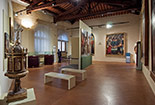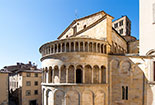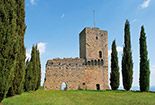THE MEDICEA FORTRESS IN AREZZO AND THE PRATO
in Arezzo, Tuscan art city that you can know in every detail with this website
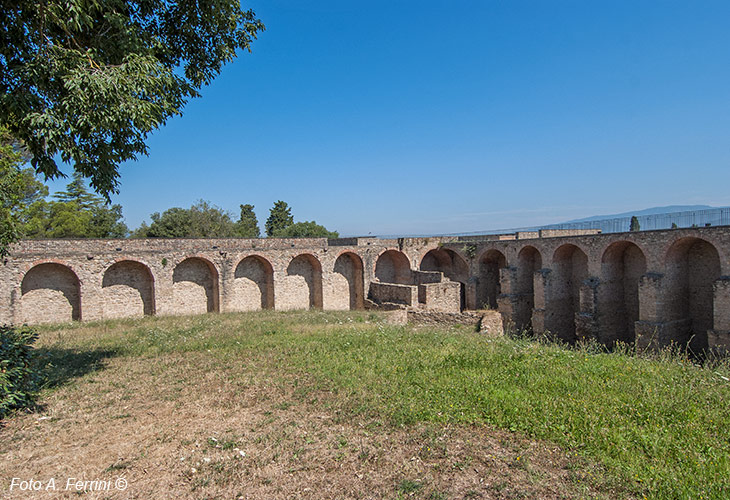
Texts and photos by Alessandro Ferrini ©
35 accurately described images of the Prato of Arezzo and the Medici Fortress. Click to enlarge
The Prato and the Medici Fortress of Arezzo
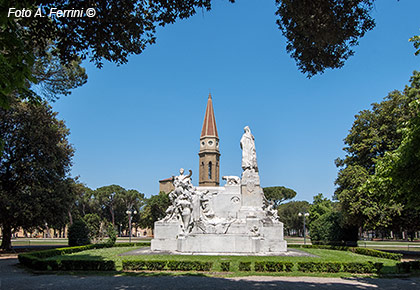 Until the eighteenth century, the apex of the small hill on whose southern slopes the oldest part of Arezzo is located had a very different conformation from the present one. The top of this hill was divided into two small peaks: one was the hill of San Pietro where the Arezzo cathedral was and still is. The other, a few meters higher, was the hill of San Donato. The latter, since the origins of the city, has always had a considerable strategic importance because it allowed you to have a 360 degree view of the surrounding area. Recent archaeological excavations carried out here have brought to light the remains of Roman constructions.
The Lombards were certainly the first to build a fortress there to defend Arezzo, then, in the eleventh century, with the feudal bishops of the city, another more substantial one was built.
The hills of San Pietro and San Donato were divided by a saddle in the ground, a sort of division between military and religious power. This was also a place of great historical and architectural importance. Here was the Roman Etruscan forum with buildings, columns, arcades, statues. With an enormous work that lasted from the second half of the seventeenth century to the early nineteenth century, the saddle was filled so as to be able to constitute a flat area where a large elliptical garden was created which was inaugurated in 1809 with the name Il Prato . The aim was to give Arezzo a nice place to walk, to meet, as well as a space for fairs and other events. In 1928, in the center of the park, the great monument dedicated to Francesco Petrarca was placed. The Prato begins a few meters from the apse and the bell tower of the cathedral. Next to this church and along a path that leads to Prato from the top of the escalators is the "Piazzetta behind the Duomo". A large bell dated 1359 is exhibited here. Until 1539, it belonged to the Town Hall, which was demolished in that year by the Florentines as part of the works that were to give Arezzo a more Renaissance style. The bell was donated to the cathedral.
Behind the monument to Petrarch, a tree-lined path leads in a hundred meters to the fortress mentioned above. The most important and well-documented history of this defensive structure begins in the last decade of the twelfth century in conjunction with the construction of the second city wall of Arezzo designed to strengthen this defensive element. As part of these works, the fortress was also strengthened.
Until the eighteenth century, the apex of the small hill on whose southern slopes the oldest part of Arezzo is located had a very different conformation from the present one. The top of this hill was divided into two small peaks: one was the hill of San Pietro where the Arezzo cathedral was and still is. The other, a few meters higher, was the hill of San Donato. The latter, since the origins of the city, has always had a considerable strategic importance because it allowed you to have a 360 degree view of the surrounding area. Recent archaeological excavations carried out here have brought to light the remains of Roman constructions.
The Lombards were certainly the first to build a fortress there to defend Arezzo, then, in the eleventh century, with the feudal bishops of the city, another more substantial one was built.
The hills of San Pietro and San Donato were divided by a saddle in the ground, a sort of division between military and religious power. This was also a place of great historical and architectural importance. Here was the Roman Etruscan forum with buildings, columns, arcades, statues. With an enormous work that lasted from the second half of the seventeenth century to the early nineteenth century, the saddle was filled so as to be able to constitute a flat area where a large elliptical garden was created which was inaugurated in 1809 with the name Il Prato . The aim was to give Arezzo a nice place to walk, to meet, as well as a space for fairs and other events. In 1928, in the center of the park, the great monument dedicated to Francesco Petrarca was placed. The Prato begins a few meters from the apse and the bell tower of the cathedral. Next to this church and along a path that leads to Prato from the top of the escalators is the "Piazzetta behind the Duomo". A large bell dated 1359 is exhibited here. Until 1539, it belonged to the Town Hall, which was demolished in that year by the Florentines as part of the works that were to give Arezzo a more Renaissance style. The bell was donated to the cathedral.
Behind the monument to Petrarch, a tree-lined path leads in a hundred meters to the fortress mentioned above. The most important and well-documented history of this defensive structure begins in the last decade of the twelfth century in conjunction with the construction of the second city wall of Arezzo designed to strengthen this defensive element. As part of these works, the fortress was also strengthened.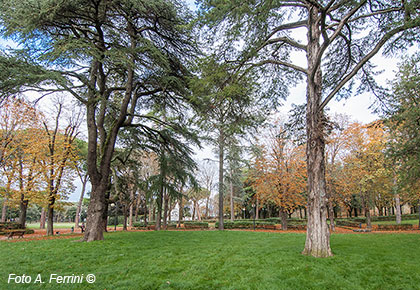 In the twenties of the 14th century, the ambitious Bishop Guido Tarlati, lord of the city since 1321, with the project to re-emerge Arezzo after the blow suffered by the Florentines in the Battle of Campaldino in 1289, put his hand to the reconstruction of robust walls that were also expanded as perimeter. The fortress aligned itself with this project. The situation for this defensive structure remained the same until 1502 when Florence, which had had full dominion over the city for almost one hundred and twenty years, began a new reconstruction of the fortress based on a project by the brothers Giuliano and Antonio da Sangallo the Elder. This enlarged considerably, became taller and had a pentagonal plan with a bastion for each corner. The works lasted for a few decades. They stopped in 1530 and resumed eight years later by specific will of Cosimo I De 'Medici.
The sturdy walls had a sort of cavity formed by large corridors and rooms that can now be partially visited and home to art exhibitions. One of the most unassailable military structures in Tuscany was built. With it, the Medici did not intend only to defend Arezzo, but also the Tuscan territory from the nearby Papal State. The works were declared completed only in 1560, coinciding with the construction of a new wall always wanted by the Grand Duke Cosimo I. For the realization of this a philosophy was adopted opposite that of Guido Tarlati. In fact, its perimeter was significantly reduced so that it was better defendable. It was also equipped with bulwarks and ramparts protruding outside the wall and in sight between them. These were adapted to accommodate many soldiers and also new heavy weapons such as cannons.
For two and a half centuries, the fortress of Arezzo was a feather in the cap for the city and beyond. At the end of the 18th century it was partially dismembered by the attack that the French troops brought to Arezzo. The political situation in the Italian peninsula had changed a lot compared to three centuries earlier and Florence did not consider it necessary to invest in its reconstruction, so the structure went towards inevitable degradation. With the unification of Italy, then, the fortress of Arezzo lost all military significance. A plaque placed above its entrance door briefly recalls its history and which in 1868 was purchased by Enrico Falciai Fossombroni in order to remove it from oblivion. The latter, who became a senator of the Kingdom of Italy in 1886, was the adopted son of the more famous Vittorio Fossombroni, who, on behalf of the Grand Duke Pietro Leopoldo of Lorena, designed and carried out the great work for the reclamation of the Valdichiana. Enrico then donated the fortress to the Municipality of Arezzo so that it was destined for public utility.
In the twenties of the 14th century, the ambitious Bishop Guido Tarlati, lord of the city since 1321, with the project to re-emerge Arezzo after the blow suffered by the Florentines in the Battle of Campaldino in 1289, put his hand to the reconstruction of robust walls that were also expanded as perimeter. The fortress aligned itself with this project. The situation for this defensive structure remained the same until 1502 when Florence, which had had full dominion over the city for almost one hundred and twenty years, began a new reconstruction of the fortress based on a project by the brothers Giuliano and Antonio da Sangallo the Elder. This enlarged considerably, became taller and had a pentagonal plan with a bastion for each corner. The works lasted for a few decades. They stopped in 1530 and resumed eight years later by specific will of Cosimo I De 'Medici.
The sturdy walls had a sort of cavity formed by large corridors and rooms that can now be partially visited and home to art exhibitions. One of the most unassailable military structures in Tuscany was built. With it, the Medici did not intend only to defend Arezzo, but also the Tuscan territory from the nearby Papal State. The works were declared completed only in 1560, coinciding with the construction of a new wall always wanted by the Grand Duke Cosimo I. For the realization of this a philosophy was adopted opposite that of Guido Tarlati. In fact, its perimeter was significantly reduced so that it was better defendable. It was also equipped with bulwarks and ramparts protruding outside the wall and in sight between them. These were adapted to accommodate many soldiers and also new heavy weapons such as cannons.
For two and a half centuries, the fortress of Arezzo was a feather in the cap for the city and beyond. At the end of the 18th century it was partially dismembered by the attack that the French troops brought to Arezzo. The political situation in the Italian peninsula had changed a lot compared to three centuries earlier and Florence did not consider it necessary to invest in its reconstruction, so the structure went towards inevitable degradation. With the unification of Italy, then, the fortress of Arezzo lost all military significance. A plaque placed above its entrance door briefly recalls its history and which in 1868 was purchased by Enrico Falciai Fossombroni in order to remove it from oblivion. The latter, who became a senator of the Kingdom of Italy in 1886, was the adopted son of the more famous Vittorio Fossombroni, who, on behalf of the Grand Duke Pietro Leopoldo of Lorena, designed and carried out the great work for the reclamation of the Valdichiana. Enrico then donated the fortress to the Municipality of Arezzo so that it was destined for public utility.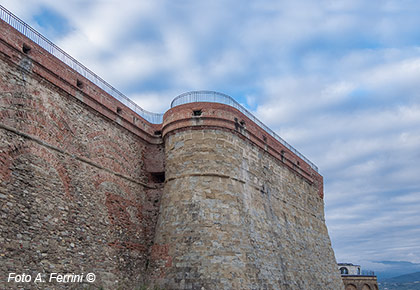 In 1997, a major restoration project began which lasted for several years. Today the Medici Fortress can be visited. In addition to the charm of its military architecture, it offers us a great view of the city and a lot of surrounding territory. It is also possible, in part, to go around it. From viale Guido Tarlati, a small road that initially flanks the Vasari aqueduct and then the municipal cemetery takes us right under the mighty walls of the structure.
At the beginning of this text we mentioned two entrances to the Prato: the one generally used a few meters from the apse of the cathedral and the street that starts along the escalators, before the last ramp. There are also two other pleasant roads that lead you. One is next to Porta Stufi, that of the escalators. An uphill road that flanks the walls of Arezzo allows you to reach the Prato in its north area which offers a beautiful view towards the Casentino. The other starts from Piazza Grande. Under the Vasari Logge there is Vicolo dell’Arco, a staircase that takes us past the palace. After going around a building, another short flight of stairs, Vicolo del Cancello, takes us a few meters from the park.
In 1997, a major restoration project began which lasted for several years. Today the Medici Fortress can be visited. In addition to the charm of its military architecture, it offers us a great view of the city and a lot of surrounding territory. It is also possible, in part, to go around it. From viale Guido Tarlati, a small road that initially flanks the Vasari aqueduct and then the municipal cemetery takes us right under the mighty walls of the structure.
At the beginning of this text we mentioned two entrances to the Prato: the one generally used a few meters from the apse of the cathedral and the street that starts along the escalators, before the last ramp. There are also two other pleasant roads that lead you. One is next to Porta Stufi, that of the escalators. An uphill road that flanks the walls of Arezzo allows you to reach the Prato in its north area which offers a beautiful view towards the Casentino. The other starts from Piazza Grande. Under the Vasari Logge there is Vicolo dell’Arco, a staircase that takes us past the palace. After going around a building, another short flight of stairs, Vicolo del Cancello, takes us a few meters from the park.




